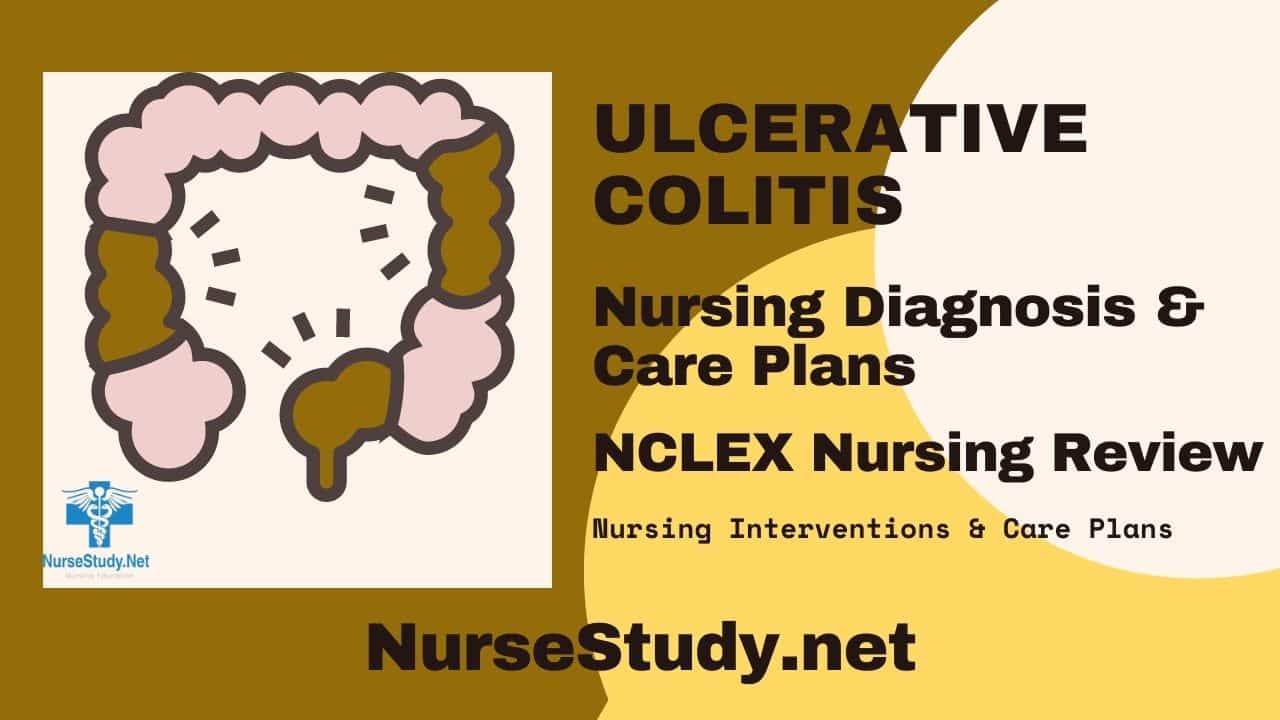Ulcerative colitis (UC) presents unique challenges for nursing care, requiring a thorough understanding of both the condition and appropriate nursing diagnoses. T
Understanding Ulcerative Colitis
Ulcerative colitis is a chronic inflammatory bowel disease that affects the colon and rectum. It causes inflammation and ulcers in the digestive tract, leading to various symptoms that require careful nursing management. Understanding the pathophysiology and manifestations of UC is crucial for developing effective nursing care plans.
Key Clinical Manifestations
- Bloody diarrhea
- Abdominal pain and cramping
- Weight loss
- Fatigue
- Rectal bleeding
- Urgency to defecate
- Joint pain
- Skin manifestations
- Eye inflammation
Nursing Assessment for Ulcerative Colitis
Physical Assessment
Abdominal Assessment
- Inspect for distention
- Palpate for tenderness
- Auscultate bowel sounds
- Check for rebound tenderness
Skin Assessment
- Check for pallor
- Assess skin turgor
- Look for extraintestinal manifestations
Vital Signs
- Monitor for fever
- Check for tachycardia
- Assess blood pressure
Nutritional Status
- Track weight changes
- Assess dietary intake
- Monitor hydration status
Laboratory and Diagnostic Assessment
Blood Tests
- Complete blood count
- Inflammatory markers
- Electrolyte levels
- Liver function tests
Stool Studies
- Fecal calprotectin
- Culture and sensitivity
- Occult blood
Imaging Studies
- Colonoscopy findings
- CT scan results
- MRI results
Primary Nursing Diagnoses for Ulcerative Colitis
Nursing Care Plan 1. Acute Pain
Nursing Diagnosis Statement: Acute Pain related to inflammation of the intestinal mucosa and increased intestinal motility as evidenced by verbal reports of abdominal pain, guarding behavior, and facial grimacing.
Related Factors/Causes:
- Inflammatory process
- Intestinal spasms
- Mucosal ulceration
- Increased bowel motility
Nursing Interventions and Rationales:
- Assess pain characteristics (PQRST)
Rationale: Provides a baseline for monitoring pain management effectiveness - Administer prescribed pain medications
Rationale: Controls pain and promotes comfort - Position patient for comfort
Rationale: Reduces abdominal pressure and discomfort - Apply a warm compress to the abdomen
Rationale: Promotes muscle relaxation and reduces cramping
Desired Outcomes:
- The patient reports decreased pain intensity
- Patient demonstrates an improved comfort level
- Patient uses effective pain management strategies
Nursing Care Plan 2. Diarrhea
Nursing Diagnosis Statement: Diarrhea related to the inflammatory process and altered bowel motility as evidenced by frequent loose stools, urgency, and abdominal cramping.
Related Factors/Causes:
- Inflammation of intestinal mucosa
- Increased intestinal motility
- Malabsorption
- Medication side effects
Nursing Interventions and Rationales:
- Monitor stool characteristics and frequency
Rationale: Provides data about disease severity and treatment effectiveness - Implement prescribed dietary modifications
Rationale: Reduces intestinal irritation and diarrhea - Maintain skin integrity
Rationale: Prevents skin breakdown from frequent stools - Monitor fluid and electrolyte balance
Rationale: Prevents dehydration and electrolyte imbalances
Desired Outcomes:
- Decreased stool frequency
- Improved stool consistency
- Maintained skin integrity
- Adequate hydration status
Nursing Care Plan 3. Risk for Impaired Skin Integrity
Nursing Diagnosis Statement: Risk for Impaired Skin Integrity related to frequent diarrhea and perianal irritation.
Related Factors/Causes:
- Frequent bowel movements
- Liquid stool
- Chemical irritation
- Nutritional deficits
Nursing Interventions and Rationales:
- Assess perianal skin regularly
Rationale: Early detection of skin breakdown - Implement proper skin care protocol
Rationale: Maintains skin integrity - Apply protective barrier cream
Rationale: Prevents chemical irritation from stool - Teach proper cleansing techniques
Rationale: Promotes self-care and skin protection
Desired Outcomes:
- Maintained skin integrity
- No signs of skin breakdown
- Patient demonstrates proper skin care techniques
Nursing Care Plan 4. Imbalanced Nutrition: Less Than Body Requirements
Nursing Diagnosis Statement: Imbalanced Nutrition: Less Than Body Requirements related to decreased absorption of nutrients and reduced oral intake as evidenced by weight loss and poor appetite.
Related Factors/Causes:
- Inflammatory process
- Reduced appetite
- Malabsorption
- Fear of eating
Nursing Interventions and Rationales:
- Monitor nutritional intake
Rationale: Identifies nutritional deficits - Implement prescribed dietary modifications
Rationale: Promotes optimal nutrition - Administer prescribed supplements
Rationale: Corrects nutritional deficiencies - Provide small, frequent meals
Rationale: Improves nutrient intake and absorption
Desired Outcomes:
- Stabilized weight
- Improved nutritional intake
- Normal laboratory values
Nursing Care Plan 5. Anxiety
Nursing Diagnosis Statement: Anxiety related to chronic illness and lifestyle changes as evidenced by expressed concerns and reported difficulty coping.
Related Factors/Causes:
- Chronic disease process
- Lifestyle modifications
- Social limitations
- Treatment concerns
Nursing Interventions and Rationales:
- Assess anxiety level
Rationale: Establishes baseline for intervention effectiveness - Provide disease education
Rationale: Increases understanding and reduces fear - Teach coping strategies
Rationale: Promotes effective stress management - Facilitate support system involvement
Rationale: Enhances emotional support
Desired Outcomes:
- Decreased anxiety levels
- Improved coping mechanisms
- Enhanced understanding of disease management
Patient Education and Discharge Planning
Key Education Points
Medication Management
- Proper administration
- Side effects
- Compliance importance
Dietary Modifications
- Foods to avoid
- Recommended foods
- Meal planning
Lifestyle Modifications
- Stress management
- Exercise recommendations
- Sleep hygiene
Warning Signs
- When to seek medical attention
- Emergency symptoms
- Follow-up care
References
- Smith, J., et al. (2024). “Current Nursing Management of Ulcerative Colitis.” Journal of Inflammatory Bowel Disease Nursing, 15(2), 45-58.
- Johnson, M., & Brown, K. (2023). “Evidence-Based Nursing Interventions in Inflammatory Bowel Disease.” American Journal of Nursing, 123(4), 28-39.
- Williams, P., et al. (2024). “Nursing Diagnosis and Care Planning in Ulcerative Colitis.” Journal of Advanced Nursing Practice, 18(1), 12-25.
- Anderson, R., & Davis, S. (2023). “Quality of Life Outcomes in UC Patient Care.” Gastroenterology Nursing, 46(3), 89-102.
- Thompson, L., et al. (2024). “Updated Guidelines for UC Nursing Care.” Clinical Nursing Research, 33(2), 67-82.
- Martinez, C., & Wilson, J. (2023). “Nursing Considerations in IBD Management.” International Journal of Nursing Studies, 92, 104-118.
- Cai Z, Wang S, Li J. Treatment of Inflammatory Bowel Disease: A Comprehensive Review. Front Med (Lausanne). 2021 Dec 20;8:765474. doi: 10.3389/fmed.2021.765474. PMID: 34988090; PMCID: PMC8720971.

